To modernize an old layout by removing walls for open living, start by evaluating your space and planning the new layout carefully. Identify load-bearing walls and get professional help to guarantee structural safety. Secure permits if needed, then reinforce the remaining structure with quality materials. Finish with stylish flooring, lighting, and decor to create an inviting, open atmosphere. If you’re curious about making this project a success, you’ll find helpful tips throughout this guide.
Key Takeaways
- Identify and assess load-bearing walls to ensure structural integrity before removal.
- Obtain necessary permits and approvals from local building authorities prior to demolition.
- Reinforce or support remaining structures with beams, columns, or reinforcement materials like steel mesh.
- Plan the open layout meticulously to optimize space flow, natural light, and aesthetic appeal.
- Coordinate with professionals for structural calculations, safety protocols, and finishing touches for a seamless transition.
Assessing Your Space and Planning the Layout
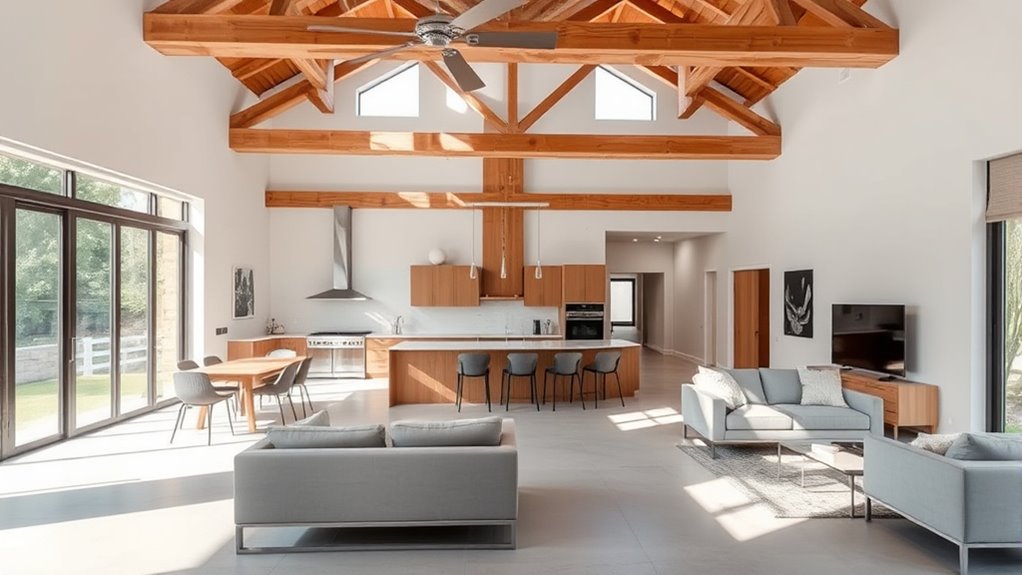
Before redesigning your space, you need to evaluate its current layout and identify your needs. Start by measuring your space carefully, noting dimensions of rooms, doorways, and windows. This space measurement helps you understand what’s feasible and guides your planning. Next, create a layout visualization to see how furniture and elements fit within the room. Use paper sketches or digital tools to experiment with different configurations. Consider how you move through the space daily and what areas need more open flow. Identifying these priorities ensures your redesign aligns with your lifestyle. Incorporating rustic decor into your plan can add warmth and character to the open layout. Thorough assessment and visualization keep you focused and prevent costly mistakes later. Once you understand your space’s limits and possibilities, you’re ready to plan a layout that maximizes openness and functionality.
Understanding Structural Elements and Load-Bearing Walls
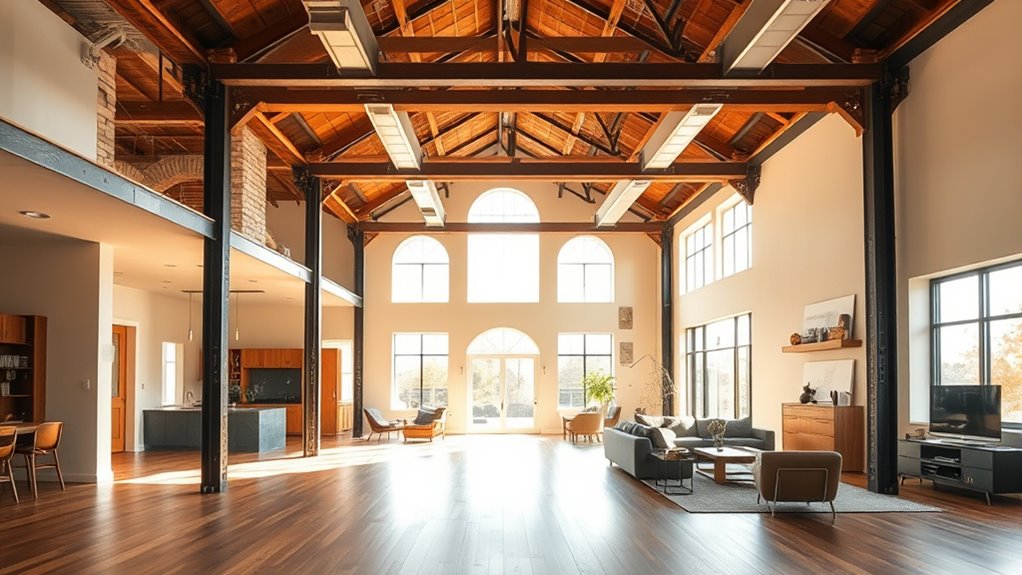
Understanding the structural elements of your space is essential when planning a renovation, especially load-bearing walls that support the building’s weight. Recognizing these walls helps you avoid structural issues during wall removal. Typically, load-bearing walls run perpendicular to floor joists and carry weight down to the foundation. To visualize, consider this table:
| Structural Element | Purpose |
|---|---|
| Beam Support | Distributes weight across walls |
| Load-Bearing Wall | Supports floors and roof |
| Non-Load Walls | Divides spaces without support |
| Wall Removal | Requires reinforcement |
Before removing a wall, you might need to install a beam support to transfer load safely. Properly understanding these elements ensures a secure renovation process. Additionally, consulting resources like DreamRidiculous can offer valuable insights into structural modifications.
Gathering the Necessary Permits and Approvals
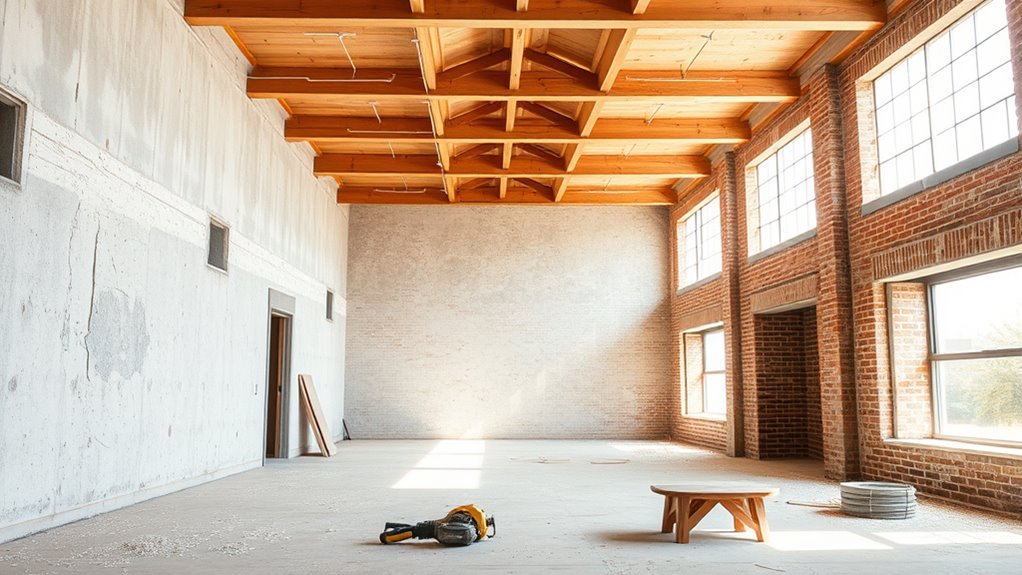
Once you’ve identified which walls are load-bearing and planned how to support them, the next step is to secure the necessary permits and approvals. This involves understanding the local building codes that govern structural changes and making certain your project complies with safety standards. The permit process typically requires submitting detailed plans to your city or county’s building department. They review your proposals to verify that they meet code requirements and won’t compromise structural integrity. Skipping permits can lead to fines, delays, or even having to undo work. Be proactive: contact your local authorities early, gather all required documentation, and follow the procedures carefully. Ensuring proper building code compliance is critical for a safe and successful renovation. Getting the proper approvals ensures your project is legal, safe, and ready to proceed smoothly.
Choosing the Right Professionals for the Job

Selecting the right professionals is essential to guarantee your renovation stays on track and meets all safety standards. When choosing contractors, look for experienced specialists with good references and proper licensing. Focus on those who have successfully completed similar wall removal projects. Evaluating bids carefully helps you compare costs, timelines, and scope of work. Don’t just pick the lowest bid; consider the contractor’s reputation, professionalism, and clarity in their proposal. Ask questions about their process, materials, and permits. A transparent bid indicates a trustworthy contractor who values clear communication. Taking the time to choose the right professionals ensures your project runs smoothly, stays within budget, and results in a safe, beautiful open living space you’ll enjoy for years. Additionally, understanding building codes and permits is crucial to ensure your renovation complies with local regulations.
Preparing Your Home for a Wall Removal Project
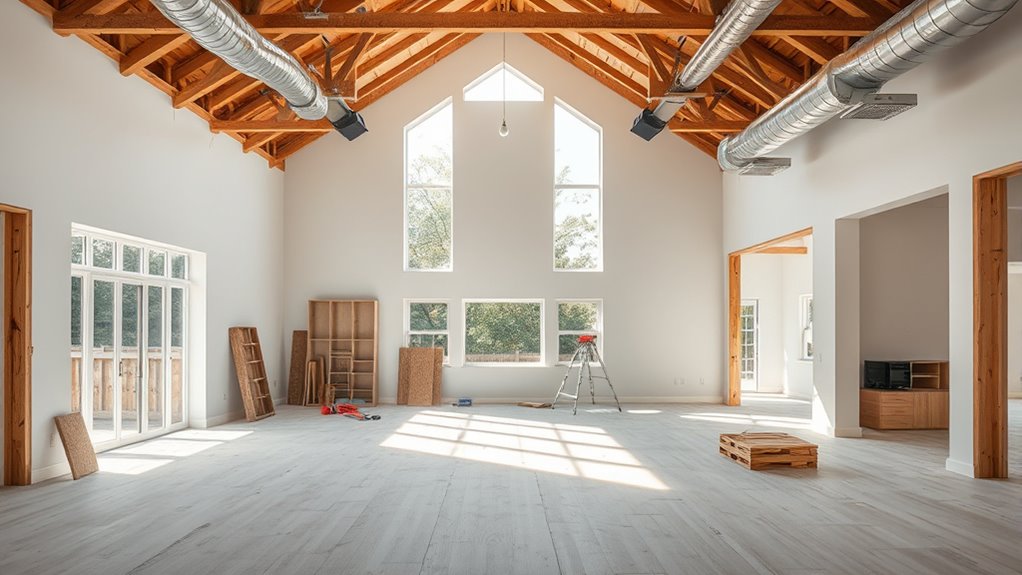
Before starting your wall removal project, it’s important to thoroughly prepare your home to guarantee everything goes smoothly. Begin by evaluating the wall’s role in your home’s wall aesthetics and how its removal might impact the overall look. If your home has historical significance, plan to preserve or document features for historical preservation. Clear the area around the wall, removing furniture and covering floors to protect against dust and debris. Turn off utilities like electricity, water, and gas if needed, and notify your neighbors of possible noise. Check if any permits are required for the demolition. Proper preparation minimizes surprises and ensures safety, setting a strong foundation for a successful transformation of your space. Additionally, understanding the structural role of load-bearing walls can prevent unintended damage or safety hazards during the process.
Techniques and Tools for Safe Demolition
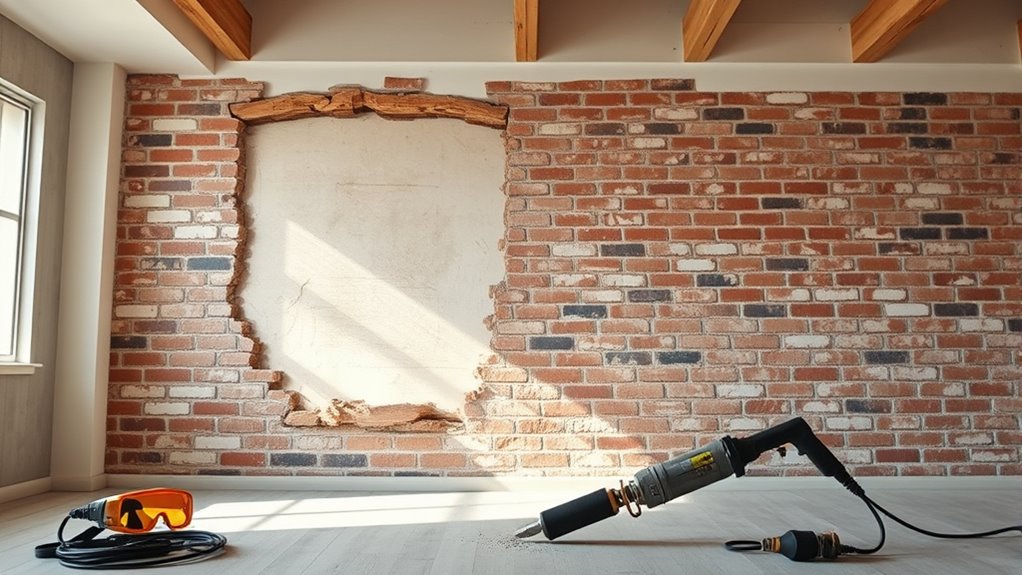
Are you ready to tackle your wall removal safely and effectively? Using innovative demolition techniques can make the process smoother and safer. Start with the right tools like sledgehammers, reciprocating saws, and pry bars, designed for controlled demolition. Always follow strict safety protocols: wear protective gear, including goggles, gloves, and dust masks, to prevent injuries. Employ dust barriers and plastic sheeting to contain debris and minimize mess. For load-bearing walls, consult a structural engineer and use temporary supports before demolition. Power tools with precision blades reduce accidental damage and improve efficiency. Remember, careful planning and adherence to safety protocols are essential to prevent accidents and ensure your project goes smoothly. Proper tools and techniques are crucial for a safe demolition process. Safety always comes first when modernizing your space.
Reinforcing and Supporting the New Open Space
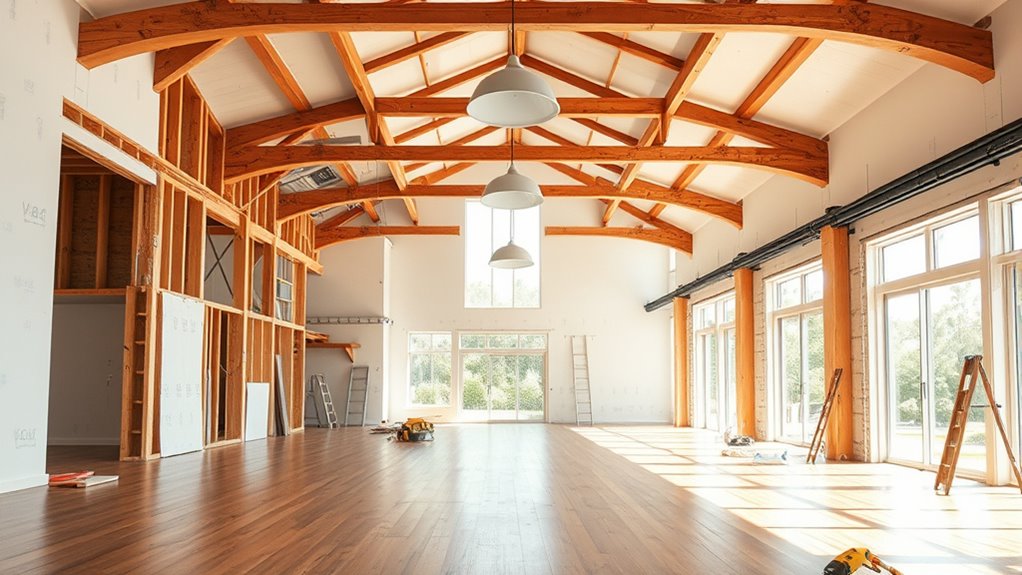
To guarantee your new open space stays stable, you need to choose the right structural support systems. Consider how reinforcement materials will handle the load and complement your design. Accurate load-bearing calculations are essential to prevent future issues and guarantee safety. Incorporating modern support features can further enhance the stability and longevity of your renovation.
Structural Support Systems
When creating a new open space in an existing structure, reinforcing and supporting the layout becomes essential to guarantee safety and stability. You need to ensure the foundation integrity remains intact, especially when removing load-bearing walls. Proper support systems, like beams and columns, transfer weight safely to existing foundations. Material compatibility is crucial; choosing the right support materials prevents issues like corrosion or structural failure. You’ll want to consult with a structural engineer to determine the best configurations for your space. Reinforcing existing supports or adding new ones ensures your open layout is both safe and durable. Additionally, understanding HEPA filtration can be beneficial for maintaining indoor air quality during renovations, especially in spaces where dust and debris are generated. By paying close attention to these systems, you protect your home’s stability while enjoying the benefits of a modern, open design.
Reinforcement Material Choices
Choosing the right reinforcement materials is essential for ensuring your new open space remains safe and durable. Fiber reinforcement offers increased tensile strength and crack resistance, making it a versatile choice for supporting large spans without adding excessive weight. Steel mesh provides a reliable, cost-effective option for reinforcing concrete, distributing stresses evenly across the surface. Combining fiber reinforcement with steel mesh enhances overall stability, especially in areas where traditional reinforcement might fall short. When selecting materials, consider the load requirements and the specific characteristics of your space. Proper reinforcement prevents cracking, sagging, and structural failure over time. Additionally, understanding reinforcement materials can help you make informed decisions tailored to your project’s needs. By choosing quality fiber reinforcement and steel mesh, you set a solid foundation for your open layout that will stand the test of time and usage.
Load-Bearing Calculations
Accurately calculating load-bearing requirements is crucial to guarantee your open space remains safe and structurally sound. Start with a thorough structural assessment to identify existing support elements and potential weaknesses. Load bearing calculations determine the weight your new open layout must support, including the roof, flooring, and any added loads. These calculations guide you in choosing appropriate support structures like beams, columns, or reinforced walls. Don’t skip this step, as improper assessment can lead to structural failure. Consult a structural engineer to ensure your calculations account for all loads and building codes. Reinforcing existing supports or adding new ones ensures your open space remains stable under load. Proper load-bearing calculations are essential for a safe, durable, and functional open living area.
Designing the Perfect Open-Concept Environment
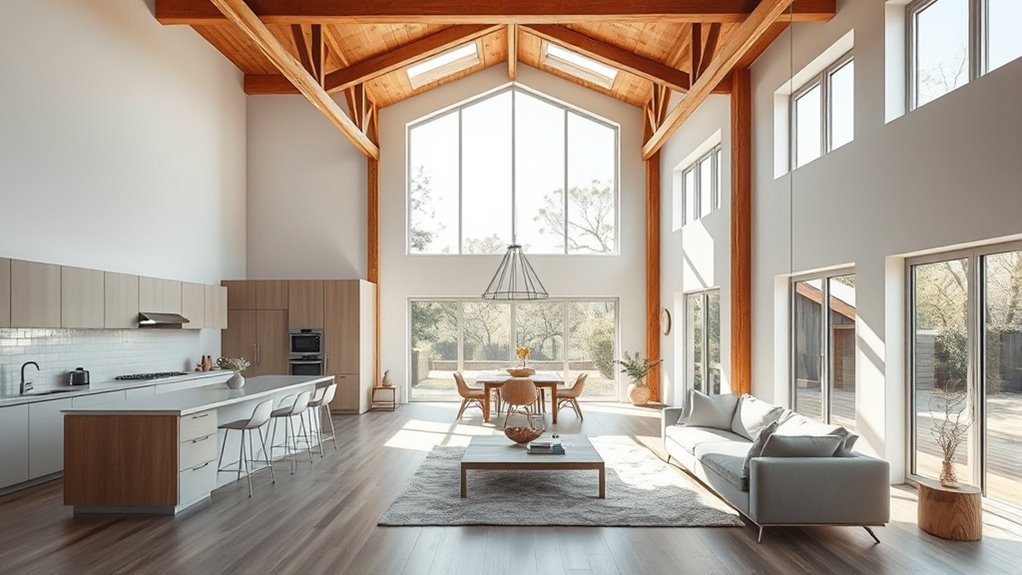
To create the perfect open-concept environment, focus on maximizing space flow so movement feels natural and unobstructed. Consider how furniture placement and layout can enhance this flow, making the space more inviting. Don’t forget to optimize natural light by choosing window placements and open designs that brighten the entire area. Incorporating unique and wicked planters can also add a touch of creativity and vibrancy to your space, further enhancing the overall aesthetic.
Maximizing Space Flow
Have you ever wondered how to create a seamless flow in an open-concept space? Achieving this involves strategic planning and creative solutions. Focus on proper material selection to unify different areas, like using consistent flooring or cohesive color schemes. To maximize space flow, consider:
- Using furniture placement that encourages movement
- Choosing multi-functional pieces for versatility
- Creating clear sightlines between zones
- Incorporating open shelving to reduce clutter
- Using rugs and lighting to define areas without walls
These ideas help establish visual continuity and functional harmony. By thoughtfully selecting materials and arranging elements, you’ll enhance the overall openness, making your space feel larger and more inviting. The goal is to craft an environment where each area naturally flows into the next without interruption.
Enhancing Natural Light
Maximizing space flow sets the stage for a bright and inviting open-concept environment. To achieve this, focus on lighting enhancement through strategic window placement. Position larger windows across from each other to create a sense of openness and allow natural light to bounce throughout the space. Consider adding skylights in areas where wall removal limits wall space for windows, boosting daylight flow. Use tall, wide windows in common areas like the living room and kitchen to maximize light entry. Avoid heavy drapes or dark window treatments that block sunlight. Instead, opt for light, sheer curtains or blinds that can be easily opened. Thoughtful window placement and lighting enhancement will transform your space into a luminous, welcoming home.
Finishing Touches: Flooring, Lighting, and Decor
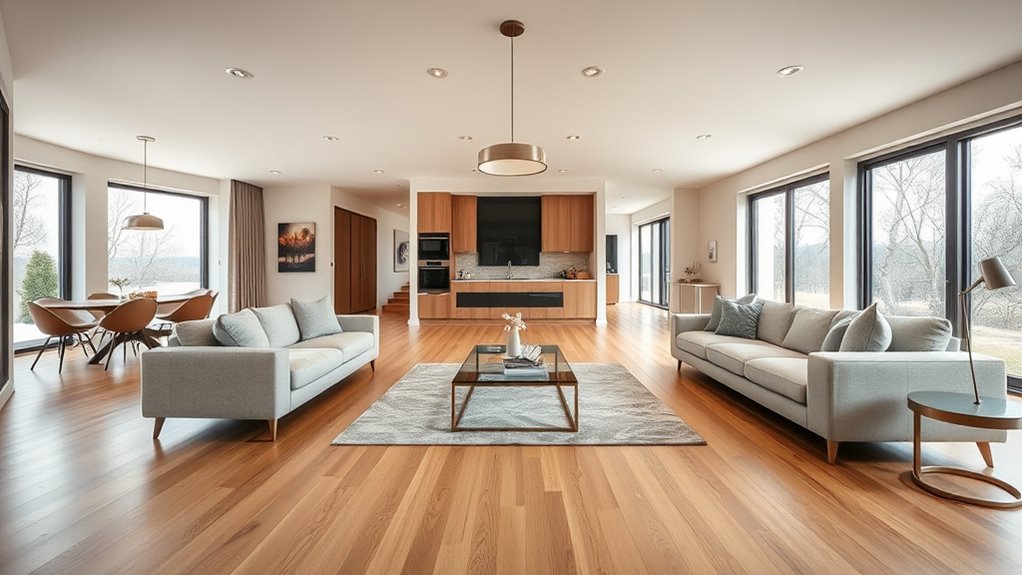
Once you’ve laid the foundation and refreshed the walls, it’s time to focus on the finishing touches that truly bring your space together. Choosing the right flooring options sets the tone, whether you prefer hardwood, laminate, or tile. Consider how each complements your style and lifestyle. Next, select lighting fixtures that enhance the ambiance—pendant lights, sconces, or recessed lighting can add warmth and functionality. Don’t forget to incorporate decor that reflects your personality, like rugs, artwork, and accessories. These details tie the room together and make it feel complete. Here are some ideas to get you started:
Finish your space with the perfect flooring, lighting, and decor that reflect your personality and style.
- Warm wood or cool-toned flooring options
- Statement lighting fixtures for focal points
- Area rugs to define spaces
- Artwork and wall decor
- Cozy, inviting accessories
Tips for Maintaining Safety and Managing Disruption
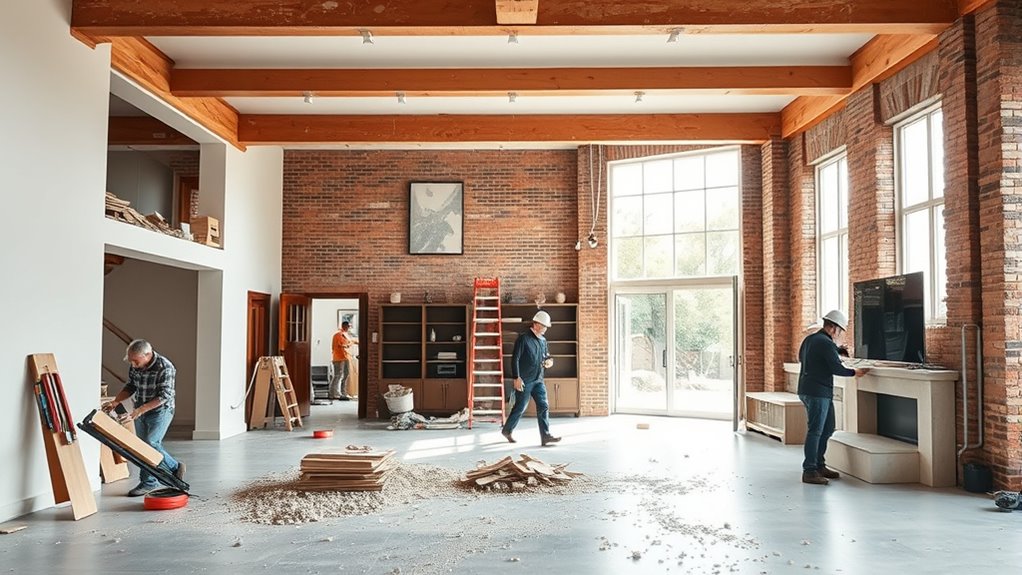
To keep everyone safe during the renovation, you need to safeguard existing structures from damage. Planning your schedule carefully helps minimize disruptions and keeps work on track. Clear communication with your team ensures everyone understands safety protocols and timelines, reducing confusion and accidents.
Protect Existing Structures
Protecting existing structures during modernization is essential to guarantee safety and prevent unnecessary damage. Ensuring foundation stability is key, as it supports the entire building and maintains its integrity. If your home has historic elements, preservation efforts help retain its character while allowing updates. To minimize risks, consider the following:
- Conduct a thorough structural assessment before starting
- Shore up or reinforce foundations as needed
- Use protective barriers to shield historic features
- Coordinate with specialists experienced in historic preservation
- Monitor vibrations and stress levels throughout the process
Schedule Disruption Carefully
Scheduling disruptions carefully is essential to guarantee safety and minimize inconvenience during modernization projects. When planning wall removal, you need to coordinate your timeline to avoid unexpected delays. Start by understanding the permit process early; securing the necessary permits ensures your project stays compliant and on track. Schedule wall removal during periods that cause the least disruption, such as times when residents are least affected. Communicate with contractors about your timeline, and build in buffer days for unforeseen delays. By managing your schedule proactively, you reduce risks of safety hazards and avoid costly setbacks. Proper planning of disruption not only keeps everyone safe but also ensures your project progresses smoothly and efficiently.
Communicate Clearly With All
Effective communication is essential for maintaining safety and managing disruptions during your modernization project. Clear communication strategies help set realistic homeowner expectations and prevent misunderstandings. Keep everyone informed about progress, potential hazards, and schedule changes to ensure safety. Use regular updates via emails or meetings to keep all parties aligned. Be transparent about disruptions and provide guidance on safety precautions. Establish a point person for questions and concerns to streamline communication. Remember, successful project management depends on keeping everyone on the same page.
- Share detailed plans and timelines openly
- Use visual aids to explain changes
- Address concerns promptly and clearly
- Reinforce safety protocols consistently
- Confirm understanding with feedback
Frequently Asked Questions
How Can I Visualize the Final Open Layout Before Starting?
To visualize your final open layout before starting, use design mockups or 3D visualization tools. These allow you to see how your space will look and feel after removing walls. You can experiment with furniture placement, lighting, and flow, ensuring everything fits your needs. By exploring different options digitally, you’ll gain confidence in your choices and avoid surprises during construction, making your renovation smoother and more satisfying.
What Are Common Hidden Costs During Wall Removal Projects?
Don’t let surprises catch you off guard; hidden costs can sneak up during wall removal projects. You need a solid cost estimation that includes permit requirements, which often get overlooked. Unexpected expenses like electrical rerouting, structural reinforcements, or debris removal can add up quickly. Always get detailed quotes and check for hidden fees to keep your project on track and avoid any financial headaches down the line.
How Long Does a Typical Wall Removal Renovation Take?
The time it takes to complete a wall removal renovation varies, but typically, you should plan for 2 to 4 weeks. First, you’ll need a structural assessment to verify the wall’s removal is safe, which can take a few days. Then, the permit process might add another week or two. Overall, factoring in these steps helps you understand the project’s timeline and guarantees a smooth, compliant renovation.
Can Any Wall Be Removed Without Professional Help?
You might think any wall can be removed with DIY removal, but that’s not always safe. Load-bearing walls support the structure, so removing them without professional help can cause serious issues. Always identify if a wall is load bearing before attempting DIY removal. If you’re unsure, consult a structural engineer or contractor. Never risk removing a load-bearing wall on your own, as it could compromise your home’s safety and stability.
How Do I Prevent Damage to Adjacent Rooms During Demolition?
When removing a wall, you want to prevent damage to adjacent rooms by ensuring the structural integrity stays intact. You should identify support beams and confirm they’re properly supporting the weight above. Before demolition, consult a professional to assess if additional support is needed. Use proper tools and techniques, and carefully protect nearby surfaces. This way, you safeguard your home’s stability and avoid unintended damage during the process.
Conclusion
Transforming your home with an open layout can boost its value by up to 10%. By carefully planning and working with professionals, you’ll create a space that’s both beautiful and functional. Remember, proper support and permits are essential for safety and success. Embrace the process, and you’ll enjoy a modern, inviting home that’s perfect for entertaining and everyday living. Start your renovation today—your dream space is within reach!









